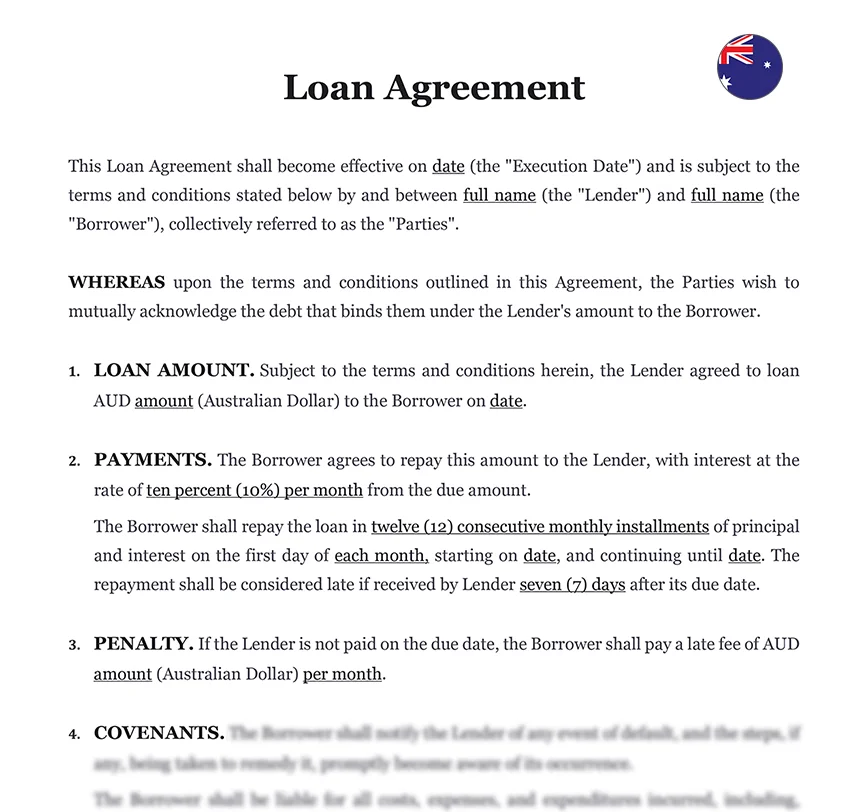The Importance of a Well-Drafted Loan Agreement
A Loan Agreement is a vital document that formalizes the terms of a loan between two parties. Whether you’re lending money to a friend, family member, or business partner, having a legally binding agreement protects both the lender and the borrower. A well-drafted Loan Agreement helps prevent misunderstandings, ensures that both parties are on the same page regarding the loan’s terms, and provides legal recourse in the event of a dispute. In Australia, creating a comprehensive personal loan agreement is essential for maintaining trust and clarity in financial transactions.
Key Components of a Loan Agreement
When drafting a Personal Loan Agreement, it is important to include specific components that clearly outline the loan’s terms and conditions. These components ensure that both parties fully understand their rights and obligations.
1. Principal Amount: The agreement should specify the exact amount of money being loaned, referred to as the principal. This is the amount that the borrower is obligated to repay.
2. Interest Rate: If interest is to be charged on the loan, the agreement must clearly state the interest rate and whether it is fixed or variable. Additionally, the method of calculating interest should be detailed.
3. Repayment Schedule: The agreement should outline the repayment schedule, including the frequency of payments (e.g., monthly, quarterly), the amount of each payment, and the total duration of the loan.
4. Late Payment Penalties: To encourage timely payments, the agreement can include penalties for late payments, such as additional interest or fees. These penalties should be clearly defined.
For those seeking guidance on structuring agreements with investors, our article on Structuring Your Company with Investor Agreements provides useful insights into creating agreements that protect both parties’ interests.
Securing the Loan
One important aspect of a Personal Loan Agreement is whether the loan is secured or unsecured. A secured loan involves collateral, which can provide additional protection for the lender.
1. Collateral: If the loan is secured, the agreement should specify the collateral being offered, such as property, vehicles, or other valuable assets. The agreement should also outline the conditions under which the collateral can be claimed by the lender in case of default.
2. Unsecured Loans: In cases where no collateral is provided, the loan is considered unsecured. Unsecured loans carry a higher risk for the lender, making it even more important to clearly define the loan terms and repayment obligations.
Legal Requirements for Personal Loan Agreements in Australia
To ensure the Loan Agreement is enforceable, it must comply with Australian legal requirements. Adhering to these requirements is crucial for protecting both parties.
1. Written Agreement: While verbal agreements can be legally binding, a written agreement is essential for clarity and enforceability. The agreement should be signed by both parties.
2. Witnesses and Notarization: Although not always required, having the agreement witnessed or notarized can provide additional legal protection.
3. Consumer Credit Regulations: If the loan is considered a consumer credit contract, it must comply with the National Consumer Credit Protection Act 2009. This legislation imposes specific requirements on lenders, including responsible lending obligations.
For more on legal agreements in other contexts, you can explore our article on Understanding Long-Term Rental Contract Rights, which delves into the complexities of leasehold arrangements.
Addressing Potential Risks
A well-drafted Loan Agreement should anticipate potential risks and include provisions to address them. This can help prevent disputes and protect the interests of both parties.
| ➤ Default and Remedies: The agreement should define what constitutes a default, such as missed payments or bankruptcy, and outline the remedies available to the lender. This could include demanding immediate repayment or taking legal action. |
| ➤ Dispute Resolution: Including a dispute resolution clause can help both parties resolve any issues that arise without resorting to litigation. Options might include mediation or arbitration. |
| ➤ Loan Modification: The agreement should specify the conditions under which the loan terms can be modified, such as changes to the repayment schedule or interest rate. |











